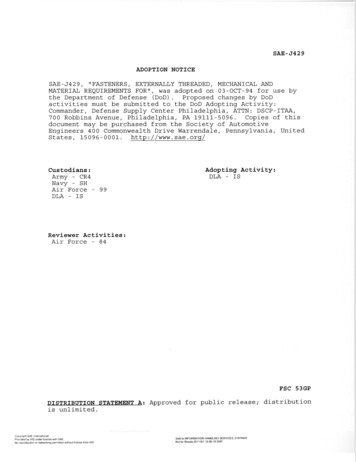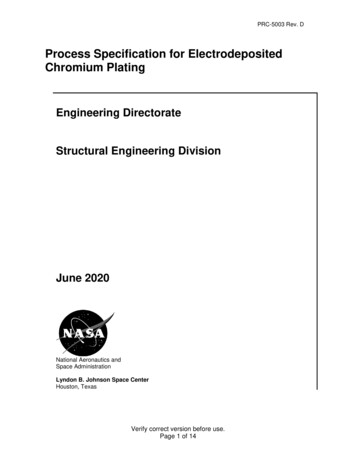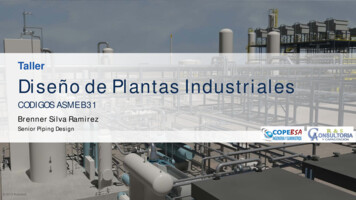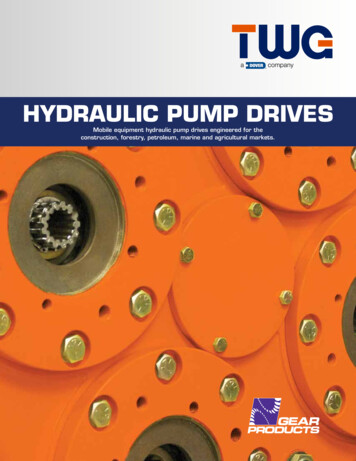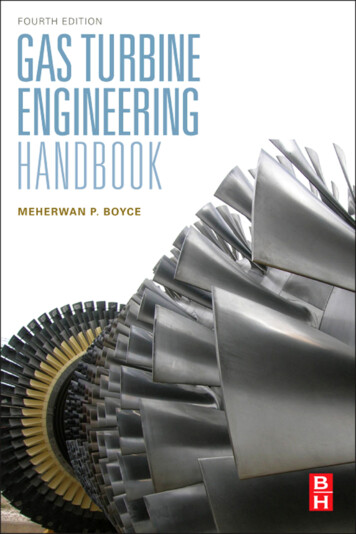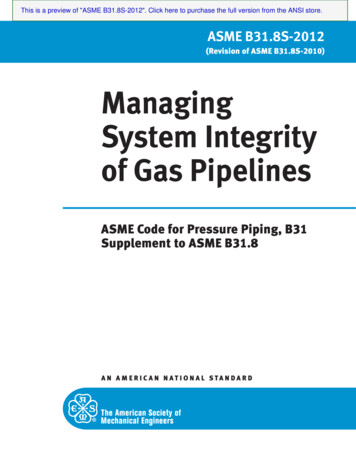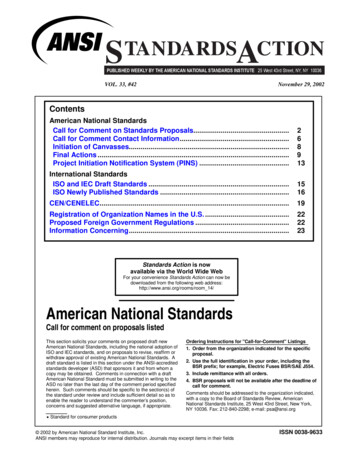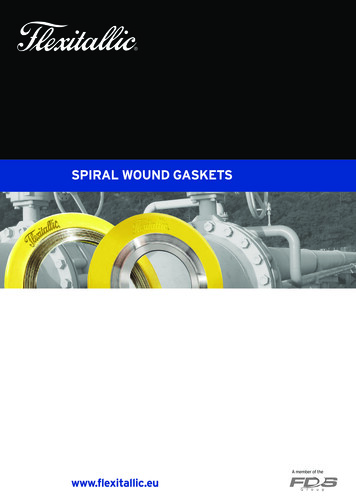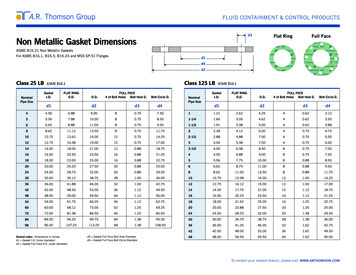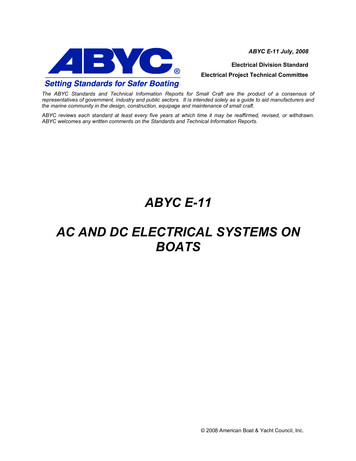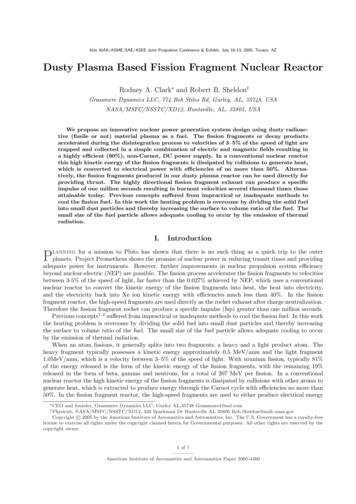
Transcription
41st AIAA/ASME/SAE/ASEE Joint Propulsion Conference & Exhibit, July 10-13, 2005, Tucson, AZDusty Plasma Based Fission Fragment Nuclear ReactorRodney A. Clark and Robert B. Sheldon†Grassmere Dynamics LLC, 774 Bob Stiles Rd, Gurley, AL, 35748, USANASA/MSFC/NSSTC/XD12, Huntsville, AL, 35805, USAWe propose an innovative nuclear power generation system design using dusty radioactive (fissile or not) material plasma as a fuel. The fission fragments or decay productsaccelerated during the disintegration process to velocities of 3–5% of the speed of light aretrapped and collected in a simple combination of electric and magnetic fields resulting ina highly efficient (90%), non-Carnot, DC power supply. In a conventional nuclear reactorthis high kinetic energy of the fission fragments is dissipated by collisions to generate heat,which is converted to electrical power with efficiencies of no more than 50%. Alternatively, the fission fragments produced in our dusty plasma reactor can be used directly forproviding thrust. The highly directional fission fragment exhaust can produce a specificimpulse of one million seconds resulting in burnout velocities several thousand times thoseattainable today. Previous concepts suffered from impractical or inadequate methods tocool the fission fuel. In this work the heating problem is overcome by dividing the solid fuelinto small dust particles and thereby increasing the surface to volume ratio of the fuel. Thesmall size of the fuel particle allows adequate cooling to occur by the emission of thermalradiation.I.Introductionlanning for a mission to Pluto has shown that there is no such thing as a quick trip to the outerPplanets. Project Prometheus shows the promise of nuclear power in reducing transit times and providingadequate power for instruments. However, further improvements in nuclear propulsion system efficiencybeyond nuclear-electric (NEP) are possible. The fission process accelerates the fission fragments to velocitiesbetween 3-5% of the speed of light, far faster than the 0.027% achieved by NEP, which uses a conventionalnuclear reactor to convert the kinetic energy of the fission fragments into heat, the heat into electricity,and the electricity back into Xe ion kinetic energy with efficiencies much less than 40%. In the fissionfragment reactor, the high-speed fragments are used directly as the rocket exhaust after charge neutralization.Therefore the fission fragment rocket can produce a specific impulse (Isp) greater than one million seconds.Previous concepts1, 2 suffered from impractical or inadequate methods to cool the fission fuel. In this workthe heating problem is overcome by dividing the solid fuel into small dust particles and thereby increasingthe surface to volume ratio of the fuel. The small size of the fuel particle allows adequate cooling to occurby the emission of thermal radiation.When an atom fissions, it generally splits into two fragments, a heavy and a light product atom. Theheavy fragment typically possesses a kinetic energy approximately 0.5 MeV/amu and the light fragment1.0MeV/amu, which is a velocity between 3–5% of the speed of light. With uranium fission, typically 81%of the energy released is the form of the kinetic energy of the fission fragments, with the remaining 19%released in the form of beta, gamma and neutrons, for a total of 207 MeV per fission. In a conventionalnuclear reactor the high kinetic energy of the fission fragments is dissipated by collisions with other atoms togenerate heat, which is extracted to produce energy through the Carnot cycle with efficiencies no more than50%. In the fission fragment reactor, the high-speed fragments are used to either produce electrical energy CEOand founder, Grassmere Dynamics LLC, Gurley AL,35748 Grassmare1@aol.comNASA/MSFC/NSSTC/XD12, 320 Sparkman Dr Huntsville AL 35805 Rob.Sheldon@msfc.nasa.govc 2005 by the American Institute of Aeronautics and Astronautics, Inc. The U.S. Government has a royalty-freeCopyright license to exercise all rights under the copyright claimed herein for Governmental purposes. All other rights are reserved by thecopyright owner.† Physicist,1 of 7American Institute of Aeronautics and Astronautics Paper 2005-4460
through direct conversion methods or to produce reaction thrust for propulsion. In direct conversion thekinetic energy of the charged fission fragments is extracted by deceleration in an electrostatic field to directlyproduce electrical energy bypassing the Carnot thermodynamic cycle. Thus energy conversion efficienciesachievable with direct conversion methods approach 90%. In the case of propulsion, the fission fragments areused as the rocket exhaust after charge neutralization. The usual performance criterion for rocket propulsionis specific impulse (Isp), which is the exhaust velocity divided by 9.8 m/s2 . The fission fragment rocket couldproduce Isp of 106 seconds compared to 350–450 s for chemical rockets or 3000–10000 s for ion engines. Asa result, burnout velocities several thousand times those attainable today would be possible.A fission fragment reactor is a nuclear reactor operating in vacuum inwhich fission fragments are continuously extracted from the reactor core.A magnetic field is used to collect and collimate the fission fragmentsinto a charged particle beam. The resulting charged particle beam is thenavailable for either direct conversion to electrical power,3 or, after neutralization, as a source of reaction thrust for a rocket propulsion system. Thefission fragment rocket has been proposed previously,1, 2 however thoseconcepts suffered from or impractical or inadequate methods to cool thefission fuel. Figure 1 shows a concept as proposed by George Chaplineat LLNL. The nuclear fuel consists of thin carbon filaments coated withfissile material that are attached to a central hub and rotated at highspeed. As they pass within the reflector moderator on each side, theyform a critical reactor where they fission and generate high-speed fissionfragments. The fragments that escape the 2 micrometer-thick fuel coatingFigure 1. Fission fragment conare collimated by the magnetic field, and are swept from the reactor core cept as proposed by Dr. Georgeto form the rocket exhaust. The deficiency of this concept arises because a Chapline. The reactor consists ofpercentage of the fragments either fail to escape the fuel layer or recollide thin carbon filaments coated withwith the fuel fibers, which can overheat and melt the fibers. Therefore nuclear fuel rotated at high speedthrough the core. Courtesy ofthe fibers must be rotated out of the reactor at high speed where they can LLNL.radiatively cool down before reentering the reactor.II.Feasibility of the Dust Based Fission Fragment Reactorn our concept of a fission fragment reactor (see Figure 2), the fuel consists of a cloud of nano-particleIfragmentsdust ( 100 nm diameter) composed of fissile material. This configuration of the fuel allows the fissionto escape from the fuel particle with a high probability.In addition, the large surface to volume ratio ofthe fuel particles enables them to transfer heat effectively by radiation directly into the space environment. The fuel particles and the fission fragmentsin the core of the reactor form a dusty plasma cloud.The significant difference in both the energy percharge and the mass per charge ratios between thefuel particles (E/q 10 5 eV/q, 105 amu/e) and thefission fragments (E/q 103 eV/q, 5 amu/e) allowsthe fissile dust to be electrostatically or magneticallycontained within the reactor core while the more energetic fission fragments are extracted for power orthrust. The electrical conversion unit is in the exhaust chamber, which operates on the principle ofdirect collection of charged particles. The electronsare first separated electromagnetically from the positive ions and allowed to flow to the ground of theelectrical system. The stream of positive fission fragment ions, carrying most of the energy, is composedof ions of different energies and is therefore of different electrical potentials. These ions are caught byFigure 2. Schematic of proposed Fission FragmentRocket. Fissile dusty plasma fuel is confined to dustchamber, where RF induction coils heat the plasma.Fission fragments are collimated by the magnetic fieldeither to collection electrodes for power, or exit the reactor for thrust.2 of 7American Institute of Aeronautics and Astronautics Paper 2005-4460
a series of electrostatic collectors, each one kept at slightly higher potential than the proceeding one. Acommon average potential will then be obtained by use of suitable dc voltage multipliers or reducers. Theresult is a high voltage dc power supply. A power plant of this type is not a heat engine, and therefore isnot Carnot-efficiency limited, consequently efficiencies as high as 90% may be possible.3 Another interestingfeature of this system should be noted: by adjusting the strength of the magnetic mirror, the system can beadjusted to produce either high Isp thrust or electrical power or both. In the next section we demonstratethe feasibility of a dust-based fission fragment reactor.A.Table 1. Some critical massesNeutronic AnalysisA neutronic analysis has been performed by others using standardcodes4 as summarized in Table 1. The reactor has been shown tobe homogeneous from the neutron’s point of view, since the meanfree path of the neutron is very long in this low density fuel. After afission generates a neutron, it exits the core and is thermalized in themoderator, entering and reentering the core many times before it isabsorbed. For the calculations shown in Table 1, the reactor core isassumed to have a one meter diameter and five meter length. Studiesof other geometries, such as thin films,5 lead to the conclusion thatthe ratio of fissionable fuel to moderator must be in the range of1/500 - 1/1000. This result implies a required dust density of 1 10 4g/cm3 . Laboratory RF-discharge dusty plasma chambers currentlyare producing this dust Cross-sectionσρν4.27 1051.65 1059.34 1044.04 1042.31 104Mass*kg0.50.9†1.15.611.0* Assumingthe fissile material uniformly fills a cylinder core with 1 meter diameter and 5 meter length insidean outer BeO neutron moderator.† Interpolated from cross-section.Fission Fragment Escape ProbabilityThe fission fragment must escape the dust particle in order to producethrust rather than heat. The probability for a fission particle to escape asingle dust particle has been calculated in the references and by us. Asshown in figure 3, the fission fragment escape probability is very high forsmall fuel dust particles, reaching nearly 100% for submicron particles.Next the fission fragment must escape the dust cloud and the reactorto either produce reaction thrust or electrical power. This escape probability depends on the fission fragment trajectory. With no magnetic fieldthe fission fragments generally follow straight-line trajectories. In thisFigure 3. Fission fragment es- situation any fragment emitted toward the wall or backward would notcape probability as a function of escape the reactor. The worst case is for a fission fragment emitted at thefuel particle size.center of a homogeneous dust cloud.For a 40 cm thick cloud of 20 cm radiusand density of 1 10 4 grams/cm3 , the escape probability is 11.4% without a magneticfield. The blue curve in figure 4b shows theescape probability as a function of emissionangle through a homogeneous dust cloud. Asexpected, only fragments emitted in the direction of the reactor exhaust escape. The situation improves dramatically if a magnetic fieldis added to guide the fission fragments fromthe reactor. An axial magnetic field causes thefragments emitted toward the wall to move incircular trajectories and avoid the wall. Alsoif the magnetic field is stronger at one end it Figure 4. a) Trajectories of fission fragments from dust cloud,acts as a magnetic mirror reflecting the frag- which reflect and exit the system. b) Histogram of escapeprobability for fission fragments as a function of directionments headed in the wrong direction. Figure and magnetic field.4a shows the curved trajectories of 4 fissionfragments as they exit the dust cloud following magnetic field lines. For a 40 cm thick cloud of 20 cm radius,3 of 7American Institute of Aeronautics and Astronautics Paper 2005-4460
the escape probability is 65% with a magnetic field. The red curve in figure 4b shows the escape probabilityas a function of emission angle through a homogeneous dust cloud in an axial magnetic field with a magneticmirror at one end. As expected, additional fragments are now redirected out the reactor exhaust. So, evena fragment emitted from the center of the dust cloud has a 65% probability of escape. Another interestingfeature of this system should be noted: by adjusting the strength of the magnetic mirror the system can beadjusted to produce either thrust or electrical power.C.Thermal ManagementThe dust in the reactor becomes hot due to the fact that a small percentage of the fragments are captured in the fuel particles and because someescaped fission fragments recollide with the dust particles. The dust isable to cool itself by emitting IR radiation. Figure 5 shows a calculationof the equilibrium fuel temperature as a function of dust particle size anda table of the melting point for several nuclear fuel candidates. Unlikethe carbon fiber fuel system, of the earlier version of the fission fragmentreactor, which must be rotated out of the reactor core in order to keepthe fibers from melting, the small size of the fuel dust particles in ourconception of the fission fragment reactor can remain sufficiently cool toremain within the reactor without melting.D.Figure 5. Equilibrium fuel particle temperature as a function ofparticle size.Magnet Field Extraction of Fission Fragments ExhaustThe next issue is to consider howthe fission fragments can be extracted from the dust cloud anddiverted out the rocket exhaust.This can be done with a magnetic field, which bends the fissionfragments accordingto the formula Bρ 14.A E/Zeff in Tesla-meters.Table 2 shows the magnetic fieldstrength necessary to confine heavyand light fission fragments and alpha particles. Field strengths betweencurrent magnet technology.Table 2. Rigidity of various fission fragments.FissionFragmentHeavyLightAlpha*Dust* AlphaAtomicweight140954108MeV /amu0.511.4210 0.0510 9Teslameters0.630.600.330.001particle from Thorium decay.0.33 and 0.63 Tesla-meters are required, which can be achieved withSeveral magnetic field configurations are possible, thesimplest being a magneticmirror concept as shown in figure 6a. The field strength requirement for a simple coil canbe reduced, however, by supplementing with multiple current loops around the perimeFigure 6. Magnetic confinement of fission fragments in a magnetic mirror.Stronger field on one end reflects fragments, weaker field on nozzle trans- ter such as the hexapole shownmits particles. Wall fields are strengthened by multipole fields such as this in figure 6b, which can reducehexapole current arrangement.the individual coil strength required by 300%. For cold-start applications such as space propulsion, this can also be implemented with acombination of permanent magnets and coils.The confinement of positive ions by a multipole magnet is demonstrated by the following experiment.7A nickel-plated Neodymium-Iron-Boron magnet with surface field approaching 1 T aligned parallel to thecylinder axis was biased to -400V in a 100mTorr atmosphere to produce a dc glow plasma discharge. Electronsemitted from the magnet ionized air molecules, and the resulting low energy positive ions were then trappedin the strong magnetic field. Two trapping populations were discovered, an outer quasi-dipolar trappingregion encircling the ring, and an inner, high-density trap inside the ring. Both the magnetic mirror force,4 of 7American Institute of Aeronautics and Astronautics Paper 2005-4460
and the geometry of the field lines prevent the positive ion plasma from impacting on the negatively chargedmagnet, demonstrating confinement of positive ions by multipole magnetic bottle geometry.E.Charging of Dust GrainsThe fuel particles and the fission fragments in the core of the reactorform a dusty plasma cloud. The small size of the grains allows the fissionfragments to escape the fuel grains with high probability. The dust chargeis a function of many factors: dust particle size, number of 22-chargedfission fragments leaving dust, secondary electron production, and fissionfragment collisions with dust.8 The equilibrium charge on the dust canbe computed.9 We have computed the charge on fissioning dust usinga computer code to calculate the equilibrium. We found that the largepositive charge ( 22) carried off by the fission fragments causes the fuelgrains to acquire a high negative charge, which allows for the electrostaticcontainment of the fuel particles.F.Figure 7. Magnetic quadrupoleconfinement of ion plasma.Separation between Dust and Fission FragmentsDiscrimination between the confined dust and the collimatedfission fragments is made possible by the vast disparity betweenmass to charge ratio and velocity. Table 2, shows a comparisonbetween the mass to charge ratio for the fission fragments, alpha particles, and the fuel dust particles. Although the rigidityof the dust appears providentially small, suggesting magneticconfinement, the magnetic force exerted on the dust is insignificant compared to either collisions or electric forces, so thatthe dust is not significantly affected by the magnetic field. Theelectric fields that confine the dust are a product of externallyFigure 8.Magnetically confined dustyapplied fields and internal plasma equilibrium as described byplasma cloud.dusty plasma physics.6 This plasma equilibrium is determined by the density of negative dust, positive ions,electrons, and the plasma currents, which will probably require experimentation to determine. The MeVfission fragments, however, will not be constrained by the weak dusty plasma electric fields, but will becollimated by the magnetic field. Therefore large difference in E/q for fission fragments and dust, meansthat the dust can be electrostatically confined while the fission fragments remain magnetically collimated.Figure 8 shows an example of a dusty plasma with electrostatically confined the dust and magneticallyconstrained plasma. The purple glow is a dc glow discharge plasma generated in a 150 mTorr atmosphere byapplying -400V to a nickel-plated, 1cm diameter Neodymium-Iron-Boron magnet. The 3 micrometer SiO2dust grains in a tray below the magnet are negatively charged by arc discharge, levitate in a ring aroundthe magnet, and are illuminated with a 532nm green laser. With fissile dust, the charging occurs naturallywithout the need for an arc discharge.III.High Efficiency Isotope Batteriesll of the above technology can be applied to Earth based power plants. In this application, thrust isAunnecessary, so both ends of the reactor core could be designed to extract power. As Chapline notedbefore, the extraction of fission fragment power permits the isotopic separation of fission fragments, andtherefore the convenient separation of more active radioisotopes from less active ones.However, when one calculates the energy density per unit mass, one must include the mass of the requiredneutron moderator. Since this is several tons, this technology scales up nicely, but not down. On the otherhand, alpha-emitting radioisotopes do not need a moderator, and therefore can be made as small as ispractical. Nor do they emit any radioactive fission fragments, so are inherently safe. Given these properties,they are often compared to battery power, but with a higher energy density. Since space applications areoften mass-limited and may not always have sufficient solar power, nuclear batteries are aa an important atechnology as fission fragment rockets.5 of 7American Institute of Aeronautics and Astronautics Paper 2005-4460
Since heat is not an issue with these nuclear battery designs, one can replace the alpha-emitting dustwith coated filaments, and use magnetic fields to extract the alpha particles. Such a battery would testmany aspects of the reactor design without involving fissile materials.IV.Fission Fragment Rocket Specificationsince fission fragments have a 2cm penetration depth in air at 1 Atm, the fission fragment rocket can onlyoperate at low ambient pressure, outside the atmosphere. Therefore we model a deep space unmannedSprobe to estimate its capabilities. Although many details of the system remain unspecified, several importantconclusions can be reached with simple arguments.In order to maintain the low density core neededto extract the fission fragments while also containinga critical mass of fissile dust, the reactor vessel mustof necessity be large, with 1 meter diameter by 10meter long cylinder favored by Chapline. The moderator thickness needed based on neutronic analysesfor BeO, suggests a 30–50 cm blanket around thiscylinder. Simply by these volume constraints, themoderator weighs 10-20 metric tons. To mitigatethese problems, we suggest the use of LiH as a moderator, which estimate to be at least 1/4 the molarmass of BeO. We have not performed a neutronicanalysis for LiH in this configuration, but its neutronic properties have been measured,10 and foundto be favorable: a density less than that of water Figure 9. Artist’s conception of a deep space mission775kg/m3 , a stabilizing negative thermal coefficient powered by fission fragment rocket. Courtesy of NASA.for scattering neutrons, and a melting point of 688C. Scaling Chapline’s moderator mass by 0.25 therefore,resulted in a 6 ton moderator, to which we added 2 tons for radiators and liquid metal cooling, 1 ton formagnets, power recovery, and coils, for a dry weight of 9 tons. Supposing an engineering and scientificpayload of another ton, gives us an order-of-magnitude estimate of a 10 ton spacecraft. Such a spacecraft,we note, could be carried into orbit with existing space shuttle capabilities.Then we use the rocket equation, based on the high exhaust velocity of the fission fragments, to estimatethe fuel fraction of various missions by the required delta-V. The delta-V of a mission was calculated usingthe assumption of a single stage rocket that accelerates half the distance and then deaccelerates half thedistance for a total specified time duration. For example, a 10 year trip to the gravitational lens point 550AUdistant from the sun, would take a delta-V of about 2% the speed of light. We assumed that the fissionfragments had an exhaust velocity of 0.05 c (Isp 1.5 million), to obtain a fuel fraction 3% that of the rocket.We then added the mass of the fuel to the mass of the rocket to get the total mass, and multiplied by theacceleration implied by the mission profile to get the thrust required. This thrust had to be provided byfission fragments, which gave us the power level of the reactor, assuming some 46% of the fragments providedthrust. From these considerations we could estimate the power required by the fission fragment rocket toenable various missions.A 10 year mission to the 550AU gravitational lens point would require only 180kg of nuclear fuel, and a350MW reactor power, well within the calculated thermal limit of 1GW. A 30 year trip to the Oort cloud at0.5 Ly is more strenuous, requiring a 5.6 GW reactor. And a 50 year trip to Alpha Centauri, 4 Ly distant,is probably not feasible, requiring a 208 GW reactor, and consuming 240 tons of fission fuel.A.Space Radiation HazardsSince the thrust of a fission fragment rocket is radioactive nucleides, it would be prudent to estimate theenvironmental impact of launching such a space probe. From the mission profiles above, we can calculatethe mass burn rate of the reactor and therefore the amount of nuclear ash. Because the fission fragments arehighly charged, they are trapped by the magnetic field of the Earth until the rocket is outside the Earth’smagnetosphere, or about 10 Earth radii. Given the acceleration of the rocket and its mass burn rate, wecan calculate the number of moles of radioactive material that are injected in the magnetosphere, and we6 of 7American Institute of Aeronautics and Astronautics Paper 2005-4460
estimate that some fraction of them diffuse into the Earth’s atmosphere. The 350 MW mission burns 720 gof Uranium inside the magnetosphere, whereas the 5 GW mission burns 3.7 kg of Uranium before passinginto interplanetary space.The short halflife isotopes generallyTable 3. Earth contamination from 2.3kg Uraniumdecay into stable isotopes before enterRanked by molesRanked by Curiesing the troposphere, whereas the verylong halflife isotopes pose no threat ofIsotope MolesCuriesIsotope Fast Diff. Slow Diff.radioactivity. Accordingly we rank theNd 1440.050.01nCu Cs 1373600Cu3600Cutop contributors by mole fraction andRb 870.11µCuSr 901800Cu1800Cuby Curie level. One difference is that*Sr900.21800CuPm1472300Cu930Cusome minor constituents have medium toCs 1350.34mCuCe 1441900Cu770Cushort halflives, so their contribution toCs 1370.33600CuRu 108*204Cu110Cuthe Earth environment depends criticallyon the diffusion rate from the magne* From Plutonium 239 fission.tosphere. We calculate two models, onewith an unusually fast diffusion observed on space weather “stormy” days, and one with a more typicaldiffusion rate. In this calculation we use 2.3 kg of Uranium-235 (or Plutonium-239) as a typical burn. Ascan be seen, the worst offenders for Earth contamination are the 30-yr halflife isotopes of Strontium-90and Cesium-137. Even then, the amounts reaching the Earth should be compared to the 300 Curies ofCarbon-14 produced every year by cosmic rays.V.Conclusionconclusion, fission fragment reactors have several substantial benefits over other reactor designs includingelectrical efficiency and higher specific impulse thrust. Previous designs had difficulties with keepingIthenhigherreactor core cool, which we propose to overcome by using dusty plasma fuel. Several space missions areenabled by this technology, and we estimate that the environmental impact of such missions is negligible.References1 Chapline, G., “Fission fragment rocket concept,” Nuclear Instruments and Methods in Physics Research A, Vol. 271,Aug. 1988, pp. 207–208.2 Chapline, G. and Matsuda, Y., “Energy Production Using Fission Fragment Rockets,” Fusion Technology, Vol. 20, Dec1991.3 El-Wakil, M. M., Nuclear Energy Conversion, Intext Educational Publishers, Scranton, PA 18515, 2002.4 Anon., “MCNPX:Monte Carlo Nuclear Particle Interaction,” http://mcnpx.lanl.gov , 2005.5 Ronen, Y. and Shwageraus, E., “Ultra-thin Am242 Fuel Elements in Nuclear Reactors,” Nuclear Instruments & Methodsin Physics Research A, Vol. 455, 2000, pp. 442–451.6 Shulkla, P. K. and Mamun, A. A., Introduction to Dusty Plasma Physics, Series in Plasma Physics, Institute of PhysicsPublishing Ltd, Philadelphia, 2002.7 Sheldon, R. B. and Spurrier, S., “The Spinning Terrella Experiment: Initial Results,” Physics of Plasmas, Vol. 8, No. 4,2001, pp. 1111–1118.8 Abbas, M. M., Craven, P. D., Spann, J. F., Witherow, W. K., West, E. A., Gallagher, D. L., Adrian, M. L., Fishman,G. J., Tankosic, D., LeClair, A., Sheldon, R. B., and Jr., E. T., “Radiation pressure measurements on micron-size individualdust grains,” J. Geophys. Res., Vol. 108(A6), 2003, pp. 1229, doi:10.1029/2002JA009744.9 Draine, B. and Saltpeter, E. E., “On the Physics of Dust Grain Charging in Hot Gas,” The Astrophysical Journal,Vol. 231, July 1979, pp. 77–94.10 Mughabghab, S., Schmidt, E., and Ludewig, H., “Neutronic data in support of Space Propulsion,” International conferenceon nuclear data for science and technology, trieste, italy, bnl-64419, conf-970512-6, U.S. Department of Energy, may 1997.7 of 7American Institute of Aeronautics and Astronautics Paper 2005-4460
used as the rocket exhaust after charge neutralization. The usual performance criterion for rocket propulsion is speciflc impulse (Isp), which is the exhaust velocity divided by 9.8 m/s2. The flssion fragment rocket could produce Isp of 106 seconds compared to 350{450 s for chemical rockets or 3000{10000 s for ion engines. As
